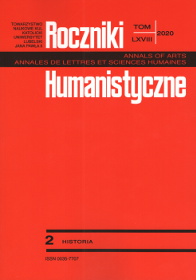Okrucieństwa wojny czy przejaw rasizmu? Przypadki znęcania się nad jeńcami z U.S. Colored Troops (USCT) na wschodnim teatrze działań wojennych wojny secesyjnej – wybrane przykłady
Abstrakt
Wojna secesyjna nie bez powodu jest uważana za przełomowy konflikt w historii USA. Jednym z takich powodów jest masowy udział Afroamerykanów, którzy po raz pierwszy od czasów wojny o niepodległość Stanów Zjednoczonych mogli służyć w armii (łącznie ok. 180 tys.). Choć wiele oddziałów U.S. Colored Troops nie było jednostkami frontowymi, to jednak część wojsk kolorowych brała czynny udział w operacjach wojskowych. Konsekwencją tego faktu było zaistnienie kwestii czarnoskórych jeńców. Oczywiście w tym wypadku warunkiem koniecznym było wzięcie ich do niewoli przez oddziały Południa. Niestety znacznie częściej zdarzały się przypadki znęcania się czy wręcz bestialskiego mordowania jeńców z U.S. Colored Troops (np. Olustee – 20 lutego 1864 r., Plymouth – 20 kwietnia 1864 r. itp.). Czy takie zachowanie żołnierzy konfederackich mieściło się w szeroko pojętych okrucieństwach wojny, rozumianych jako chęć wzięcia odwetu na oddziałach wroga, który plądruje ojczystą ziemię, chęć pomszczenia bliskich lub przyjaciół, którzy zginęli od kul przeciwnika itd. Czy jest to problem głębszy, mający swoje uwarunkowania w kulturze Południa, którego podstawą ideową było istnienie tzw. demokracji panów (Herrenvolk democracy), głęboko zakorzenione przekonanie o wyższości rasy białej nad czarną (nieobce także na Północy), które znalazło swoje odzwierciedlenie nie tylko w przemowach polityków Południa, a później Skonfederowanych Stanów Ameryki, ale także w konstytucji tego kraju.
Bibliografia
Bates Samuel P., History of Pennsylvania Volunteers, 1861-5, t. V, Harrisburg: B. Singerly, State Printer 1871.
Bernard George S., War Talks of Confederate Veterans, Petersburg: Fenn & Owen, Publishers 1892.
Burchard Peter, One Gallant Rush. Robert Gould Shaw and His Brave Black Regiment, New York: St. Martin’s Press 1989.
Coles David J., “Shooting Niggers Sir”. Confederate Mistreatment of Union Black Soldiers at the Battle of Olustee, w: Black Flag Over Dixie. Racial Atrocities and Reprisals in the Civil War, Gregory J. W. Urwin, Carbondale: Southern Illinois University Press 2004.
Cornish DudleyT., The Sable Arm. Black Troops in the Union Army, 1861-1865, Lawrence: University of Kansas Press 1987.
Day William A., A True History of Company I, 49th Regiment, North Carolina Troops in the Great Civil War between the North and South, Newton: Enterprise Job Office 1893.
Derengowski Piotr, Polacy w wojnie secesyjnej 1861-1865, Oświęcim: Napoleon V 2015.
Derengowski Piotr, The Polish Voice on Slaves and Slavery in the United States in Mid-Nineteenth Century, w: East Central Europe in Exile, t. II, red. Anna Mazurkiewicz, Newcastle upon Tyne: Cambridge Scholar Publishing 2013.
Dobak William A., Freedom by the Sword. The U.S. Colored Troops, 1862-1867, Washington: Center of Military History United States Army 2011.
Duncan Russel, Where Death and Glory Meet. Colonel Robert Gould Shaw and the 54th Massachusetts Infantry, Athens: University of Georgia Press 1999.
Emilio Luis F., History of the Fifty-Fourth Regiment of Massachusetts Infantry, 1863-1865, Boston: The Boston Book Company 1891.
Foner Eric, Give me Liberty! An American History, t. I-II, New York–London: W. W. Norton & Company 2012.
Foner Eric, The Fiery Trial. Abraham Lincoln and American Slavery, New York–London: W. W. Norton & Company 2010.
Grimsley Mark, “A Very Long Shadow”. Race, Atrocity, and the American Civil War, w: Black Flag Over Dixie. Racial Atrocities and Reprisals in the Civil War, red. G.J.W. Urwin, Carbondale: Southern Illinois University Press 2004.
Hargrove Hondon B., Black Union Soldiers in the Civil War, Jefferson–London: McFarland & Company, Inc. Publishers 2003.
Jordan Jr. Weymouth T., Thomas Gerald W., Massacre at Plymouth April 20, 1864, w: Black Flag Over Dixie. Racial Atrocities and Reprisals in the Civil War, red. G.J.W. Urwin, Carbondale: Southern Illinois University Press 2004.
Kopaliński Władysław, Słownik wyrazów obcych i zwrotów obcojęzycznych z almanachem, Warszawa: Świat Książki 2000.
McPherson James M., Marching Toward Freedom. Blacks in the Civil War 1861-1865, Facts On File An Infobase Holdings Company 1994.
McPherson James M., The Negro’s Civil War. How American Negroes Felt and Acted During the War for the Union, New York: Pantheon Books A Division of Random House 1965.
Michałek Krzysztof, Dyplomaci i okręty. Z dziejów polityki zagranicznej Skonfederowanych Stanów Ameryki, Warszawa: PWN 1987.
Phillips B.F., Wilcox’s Alabamians in Virginia, „Confederate Veteran” 15 (1907), nr 11.
Słoński Adam, Pogląd na Stany Zjednoczone Północnej Ameryki, oraz na wojnę toczącą się obecnie w tym kraju, i przyczyny, które są głównym jej powodem, Warszawa: Drukarnia Gazety Polskiej 1864.
Suderow Bryce A., The Battle of the Crater. The Civil War’s Worst Massacre, w: The Black Flag Over Dixie. Racial Atrocities and Reprisals in the Civil War, red. G.J.W. Urwin, Carbondale: Southern Illinois University Press 2004.
Trudeau Noah A., Like Men of War. Black Troops in the Civil War 1862-1865, Boston–New York–Toronto–London: Southern Illinois University Press 1998.
Urwin Gregory J.W., “We Cannot Treat Negroes … as Prisoners of War”. Racial Atrocities and Reprisals in Civil War Arkansas, w: Black Flag Over Dixie. Racial Atrocities and Reprisals in the Civil War, red. G.J.W. Urwin, Carbondale: Southern Illinois University Press 2004.
Urwin Gregory J.W., Introduction. Warfare, Race, and the Civil War in American Memory, w: Black Flag Over Dixie. Racial Atrocities and Reprisals in the Civil War, red. G.J.W. Urwin, Carbondale: Southern Illinois University Press 2004.
Warner Ezra J., Generals in Blue. Lives of the Union Commanders, Baton Rouge: LSU Press 1964.
Copyright (c) 2020 Roczniki Humanistyczne

Utwór dostępny jest na licencji Creative Commons Uznanie autorstwa – Użycie niekomercyjne – Bez utworów zależnych 4.0 Międzynarodowe.





